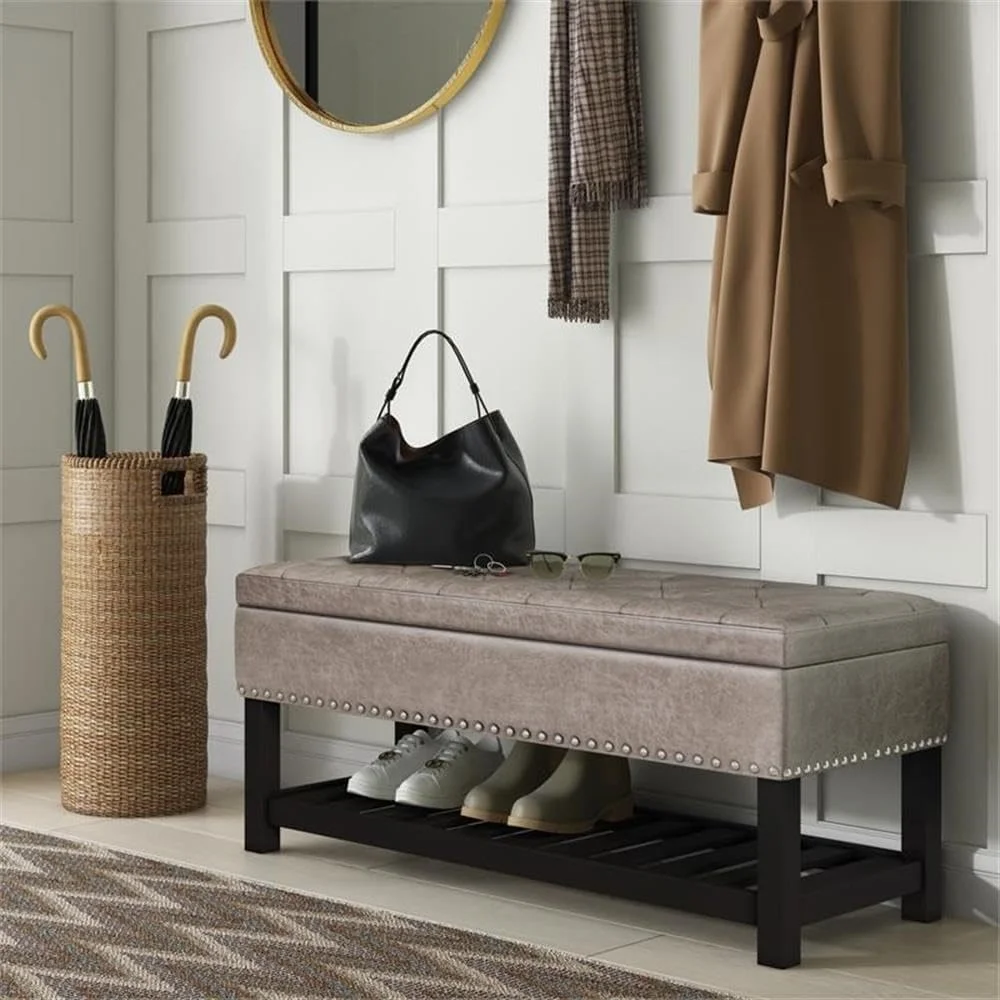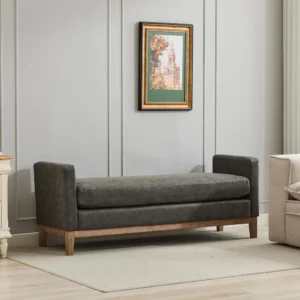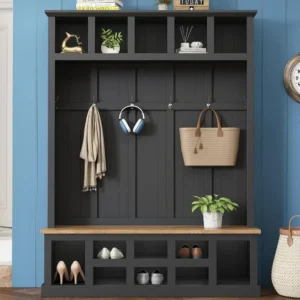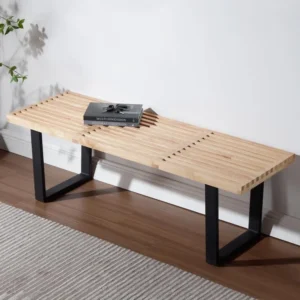Introduction: The Versatile Appeal of Upholstered Storage Benches
In the quest for creating harmonious living spaces, furniture that serves multiple purposes has become increasingly valuable. Upholstered storage benches stand out as perfect examples of this ingenious blend of form and function. These versatile pieces combine the luxurious comfort of padded seating with cleverly concealed storage compartments underneath, offering an elegant solution to the eternal challenge of maintaining an organized home.
As living spaces continue to evolve, particularly in urban environments, the popularity of space-saving entryway ideas has soared. Homeowners and apartment dwellers alike are discovering the remarkable efficiency of furniture that performs double duty. Upholstered storage benches have emerged as standout solutions that don’t force you to choose between comfort and practicality—they deliver both in one stylish package.
Whether positioned in entryways to welcome guests and store shoes, at the foot of beds to hold extra linens, or in living rooms for additional seating and blanket storage, these benches add both function and visual appeal to any space. What began as purely utilitarian storage pieces have evolved into statement furniture that can anchor a room’s design while simultaneously solving storage dilemmas.
Throughout this guide, we’ll explore the various types, placements, materials, and styling options for upholstered storage benches, helping you discover the perfect piece to enhance your home’s comfort, organization, and aesthetic appeal.
Why Upholstered Storage Benches Are Essential Home Additions
Maximizing Function in Minimal Space
In today’s homes where every square foot counts, furniture that serves multiple purposes isn’t just convenient—it’s essential. Upholstered storage benches excel by combining two fundamental furniture needs—seating and storage—into a single, space-efficient footprint. Rather than dedicating floor space to separate chairs and storage units, one thoughtfully placed bench can fulfill both roles beautifully.
This dual functionality makes these pieces particularly valuable for:
- Apartments and smaller homes where space is at a premium
- Open-concept living areas that benefit from multifunctional room dividers
- Growing families who need flexible solutions that adapt to changing needs
- Anyone seeking to reduce visual clutter while maintaining necessary storage
Beauty Meets Practicality
Unlike purely utilitarian storage solutions, upholstered storage benches contribute significantly to your home’s aesthetic appeal. The soft, inviting upholstery transforms what could be a basic storage box into an elegant seating option that enhances your decor. These benches create visual interest through:
- Textural contrast with other furniture pieces
- Opportunities to introduce accent colors or complementary patterns
- Sophisticated design details like tufting, piping, or decorative legs
- Softening of spaces that might otherwise feel stark or utilitarian
For homeowners seeking to maximize their investment, entryway bench storage options offer exceptional value compared to purchasing separate seating and storage pieces. Not only is the initial investment often lower, but the space saved can be substantial.
The versatility of these pieces extends across virtually every room in the home. From mudrooms where they corral outdoor gear to bedrooms where they provide a convenient spot to sit while dressing, upholstered storage benches adapt to diverse needs without sacrificing style. This adaptability makes them particularly valuable in homes where needs change frequently or spaces serve multiple functions.
For those with limited entryway space, best small benches for entryways provide specifically designed solutions that maximize functionality without overwhelming the available area.
Types of Upholstered Storage Benches
When shopping for the perfect upholstered storage bench, understanding the various types available helps narrow down options to find the ideal match for your needs. These versatile pieces come in several distinct categories based on both storage mechanism and design style.
By Storage Mechanism
The way a bench stores and accesses items significantly impacts its functionality and best use cases:
Lift-Top Storage Benches
These feature a hinged seat that opens upward, revealing a single large compartment beneath. Benefits include:
– Maximum storage capacity for larger items
– Clean, uninterrupted exterior appearance
– Ability to store bulkier items like blankets, pillows, or winter gear
– Simple construction with fewer moving parts
Drawer Storage Benches
Featuring pull-out drawers beneath the seat, these benches offer:
– Easier access without needing to remove items from the seating surface
– Better organization with natural compartmentalization
– Visibility of contents without having to lift the entire top
– Suitability for storing smaller, frequently accessed items
The variety of entryway bench drawers available makes these particularly popular for organizing smaller items like gloves, scarves, and other accessories that benefit from separation.
Cubby/Open Storage Benches
These benches feature open compartments, sometimes with removable baskets:
– Provide easy visual access to contents
– Allow for decorative display of items when desired
– Often accommodate standard-sized storage baskets or bins
– Create a more casual, accessible feel
Hinged-Seat Benches
Similar to lift-tops but with different hinging mechanisms:
– May open from the front rather than the top
– Sometimes include safety features like slow-close hinges
– Often found in more traditional or classic designs
– Can provide easier access in tight spaces where top-lifting might be restricted
By Design Style
Beyond storage mechanisms, upholstered storage benches come in various design aesthetics to complement your home’s style:
Traditional/Classic Benches
Characterized by:
– Button tufting, often in diamond patterns
– Rolled or curved arms when arms are present
– Turned wood legs with detailed profiles
– Rich fabrics like velvet, brocade, or textured weaves
– Decorative nailhead trim or wood detailing
Modern/Contemporary Benches
Distinguished by:
– Clean, straight lines and minimal ornamentation
– Metal or simple tapered wooden legs
– Monochromatic or subtle two-tone color schemes
– Smoother upholstery with minimal tufting
– Emphasis on form following function
For homes with contemporary aesthetics, modern entryway bench options provide sleek, streamlined designs that emphasize simplicity and clean lines.
Transitional Benches
Blending traditional and contemporary elements:
– Subtle curves without excessive ornamentation
– Moderate tufting or pleating details
– Versatile neutral fabrics with textural interest
– Mixed material construction (wood with metal accents)
– Adaptable to various decor styles
Farmhouse/Rustic Benches
Featuring:
– Natural wood elements, often with distressed or weathered finishes
– Casual, comfortable upholstery in durable fabrics
– Simple construction with emphasis on sturdiness
– Neutral colors with occasional vintage-inspired patterns
– Decorative elements like X-bracing or beadboard panels
The farmhouse entryway bench collection offers specifically rustic-inspired designs that bring warmth and charm to more casually styled homes.
Each combination of storage mechanism and design style creates unique possibilities for integrating these versatile pieces into your home’s organization system and aesthetic vision.
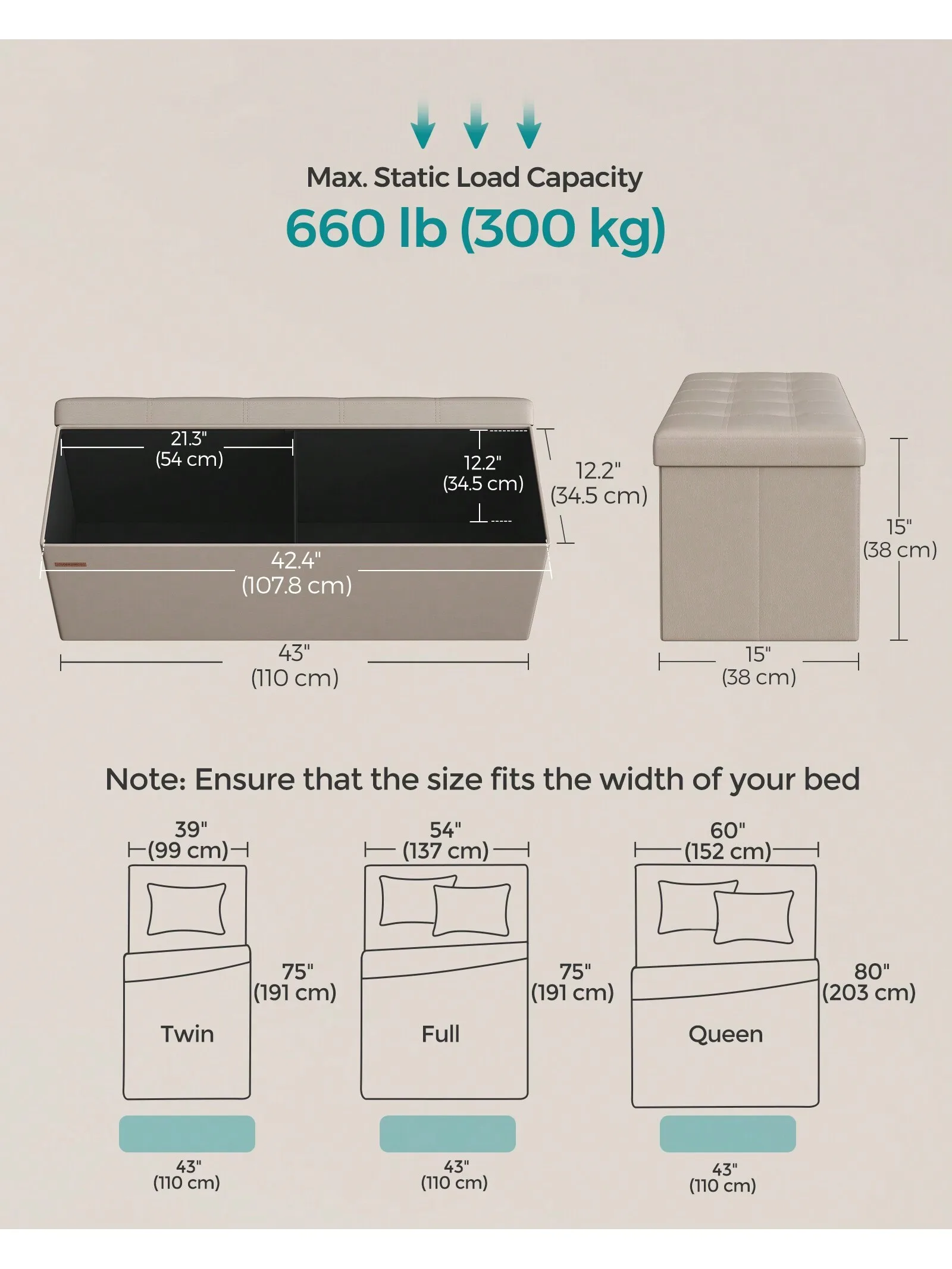
Perfect Placement: Where to Use Your Upholstered Storage Bench
The remarkable versatility of upholstered storage benches allows them to enhance practically any room in your home. Understanding the ideal placements helps maximize both their functional and aesthetic contributions to your living spaces.
Entryway/Mudroom Placement
The entryway provides perhaps the most natural home for an upholstered storage bench, creating a welcoming transition between outdoors and in:
- Creates an immediate “drop zone” for arriving home, allowing for comfortable shoe removal
- Provides hidden storage for seasonal accessories like hats, gloves, and scarves
- Establishes a strong first impression for guests entering your home
- Offers a convenient seat for putting on or removing shoes
- Prevents outdoor items from migrating further into the home
For busy families, mudroom benches specifically designed for high-traffic areas provide durable solutions that withstand daily use while maintaining organization. The key to maximizing even limited entry spaces lies in thoughtful organization—organize small entryway bench strategies can transform even compact areas into highly functional transitions.
Living Room Placement
In living areas, upholstered storage benches offer exceptional flexibility:
- Serve as alternative coffee tables with soft edges (ideal for homes with small children)
- Provide extra seating when entertaining guests
- Store media equipment, gaming accessories, or reading materials
- House throw blankets and pillows for quick access
- Function as footrests or impromptu side tables when needed
The plush upholstery adds a layer of comfort not found in traditional hard-surface coffee tables, while the storage keeps living spaces tidy and clutter-free.
Bedroom Placement
At the foot of a bed, an upholstered bench creates both function and visual balance:
- Provides convenient storage for extra bedding, pillows, or seasonal clothing
- Creates a comfortable spot for putting on shoes or laying out the next day’s clothes
- Adds a finishing touch that completes the bed’s visual frame
- Offers a place to sit while dressing without disturbing a made bed
- Creates symmetry and balance in the bedroom’s design
The soft, upholstered surface complements the bedroom’s comfort-focused atmosphere while concealing items that might otherwise create visual clutter.
Dining Area Placement
In dining spaces, storage benches can replace traditional chairs along one side of a table:
- Increases seating capacity compared to individual chairs
- Provides storage for table linens, special occasion dinnerware, or serving pieces
- Creates an interesting visual contrast with dining chairs
- Allows for flexible seating arrangements, especially for children
- Maximizes space in smaller dining areas
Home Office/Study Placement
In work or study spaces, these benches add both function and comfort:
- Create window seats with storage for office supplies or reference materials
- Provide alternative seating for reading breaks
- Store rarely-used equipment or materials
- Serve as impromptu meeting spots for quick collaborations
- Add softness to spaces often dominated by hard surfaces and technology
The key to successful placement lies in matching the bench’s dimensions and style to each specific area—considerations we’ll explore in the next section.
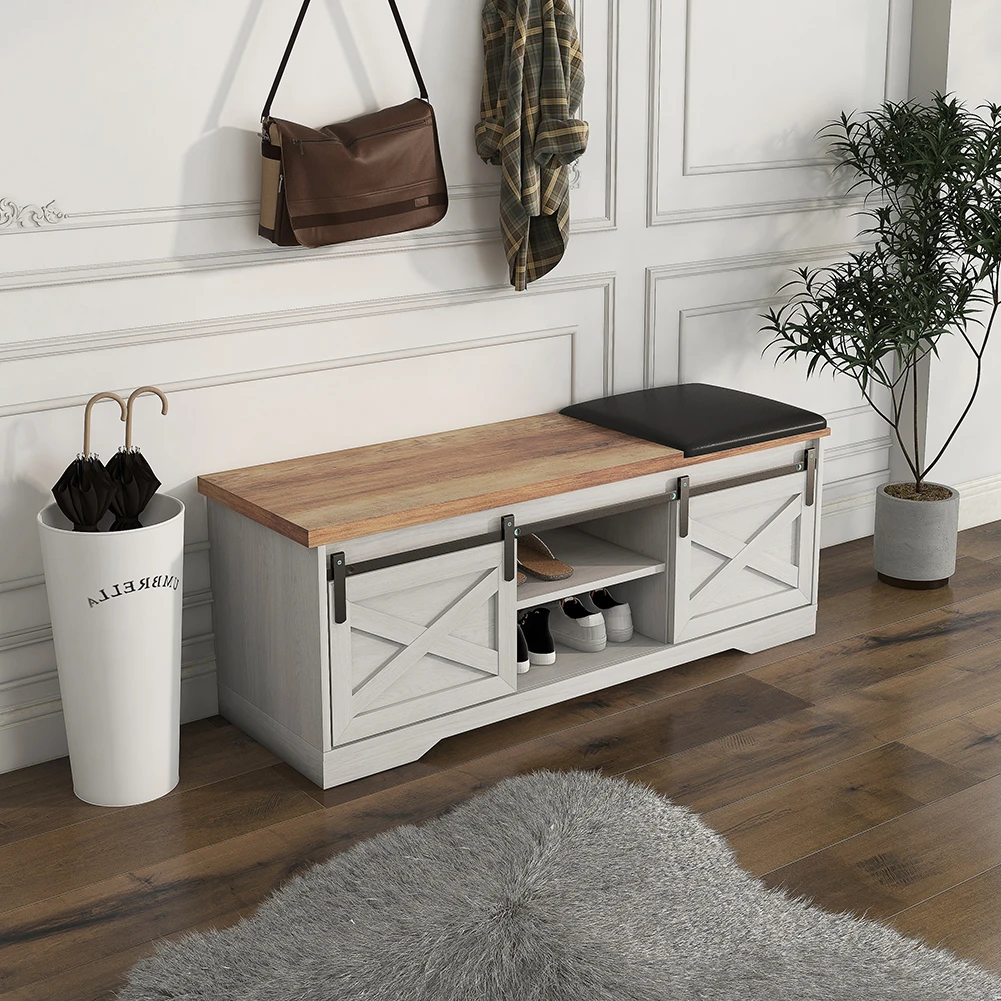
Choosing the Right Size and Dimensions for Your Space
Selecting an upholstered storage bench with appropriate dimensions ensures both visual harmony and practical functionality in your space. Too large, and the bench overwhelms the area; too small, and it fails to provide adequate seating or storage. Here’s how to find that perfect balance:
Standard Dimensions to Consider
While custom options exist, most upholstered storage benches fall within these general dimension ranges:
| Bench Type | Width | Depth | Height | Seat Height |
|---|---|---|---|---|
| Entryway | 36”-60” | 14”-18” | 18”-24” | 17”-19” |
| End-of-Bed | 40”-60” | 16”-20” | 18”-22” | 17”-19” |
| Living Room | 36”-48” | 18”-24” | 16”-20” | 16”-18” |
| Dining | 48”-72” | 14”-18” | 18”-20” | 18”-20” |
| Window Seat | Custom to window | 15”-20” | 18”-22” | 17”-19” |
Finding the perfect entryway bench height is particularly important for comfortable shoe removal and putting on, as improper height can create discomfort during daily use.
Measuring Your Space Properly
Follow these steps to accurately determine the ideal bench dimensions:
- Measure the available footprint: Determine maximum width and depth allowable without impeding traffic flow
- Consider clearance needs: Allow 18-24 inches in front of the bench for comfortable seating
- Account for opening mechanisms: Lift-top benches need overhead clearance; drawer benches need front clearance
- Consider scale: The bench should be proportionate to surrounding furniture (approximately 2/3 the width of a sofa when used as a coffee table)
- Map the placement: Use painter’s tape on the floor to visualize the bench’s footprint before purchasing
For homes with limited square footage, small entryway bench options provide specifically scaled solutions that maximize function without overwhelming modest spaces.
Seating and Storage Capacity
Balance these practical considerations:
- Seating capacity: Allow approximately 24” width per adult seated
- Storage volume: Consider what specific items need storage and measure their dimensions
- Weight capacity: Ensure the bench can support the intended number of users (typically 250-400 lbs for quality benches)
- Accessibility: Consider who will use the bench and whether the storage mechanism suits their abilities
Common Sizing Mistakes to Avoid
- Ignoring traffic flow: Ensure the bench doesn’t create bottlenecks in high-traffic areas
- Forgetting about the opened position: A lift-top bench needs clearance when open
- Choosing based on seating alone: Consider both seating comfort and storage needs
- Neglecting visual weight: Dark colors and bulky designs can make a bench feel larger in the space
Visualization techniques like creating paper templates or using AR furniture apps can help you better understand how different dimensions will work in your specific space before making a purchase.
Upholstery Materials: Balancing Beauty with Durability
The upholstery material of your storage bench significantly impacts both its appearance and longevity. Different materials offer varying benefits in terms of durability, maintenance, comfort, and visual appeal—making this choice particularly important for pieces that will see daily use.
Fabric Options
Performance Fabrics
These engineered textiles have revolutionized upholstered furniture for busy households:
– Stain-resistant treatments that repel liquids and prevent absorption
– High durability ratings (typically 30,000+ double rubs)
– Fade-resistant properties for areas with direct sunlight
– Often cleanable with simple soap and water
– Brands like Sunbrella, Crypton, and Revolution offer specialized performance features
Natural Fibers
These traditional options provide unique textures and breathability:
– Cotton: Soft, comfortable, and available in countless patterns but less stain-resistant
– Linen: Elegant with natural texture but wrinkles easily and can be difficult to clean
– Wool: Naturally stain-resistant and durable but typically higher maintenance
– Hemp and jute: Eco-friendly options with distinctive textures but rougher feel
Synthetic Fabrics
Man-made options that often balance durability and affordability:
– Polyester: Resistant to wrinkling and abrasion, available in many textures
– Microfiber: Exceptionally soft with strong stain resistance
– Velvet (synthetic): Luxurious appearance with better durability than natural velvet
– Nylon blends: Extremely durable but sometimes less soft to the touch
Leather and Leather Alternatives
Genuine Leather
A premium option that develops character over time:
– Full-grain leather: Highest quality, shows natural markings, develops patina
– Top-grain leather: Slightly processed for more uniform appearance, still very durable
– Split leather: Less expensive but less durable than top options
– Requires occasional conditioning but generally easy to wipe clean
Faux Leather/Vinyl
Budget-friendly alternatives with improving quality:
– Polyurethane (PU) leather: More breathable and flexible than vinyl
– Vinyl: Very easy to clean but less breathable and can crack over time
– Vegan leather options: Increasingly sophisticated with better durability
– Generally lower maintenance than genuine leather but shorter lifespan
Upholstery Construction Features
Beyond the exterior material, consider these construction elements:
– Padding density: Higher-density foam maintains shape longer
– Tufting styles: Button tufting creates a traditional look; channel tufting offers modern linear appeal
– Decorative elements: Nailhead trim, contrast piping, and welting add visual interest
– Pattern placement: Consider how patterns will appear across seams and panels
For areas with heavy use, benches with entryway bench cushion features that can be easily removed for cleaning or replacement offer practical longevity.
Material Selection by Household Type
| Household Type | Recommended Materials | Materials to Avoid |
|---|---|---|
| Homes with Children | Performance fabrics, microfiber, vinyl | Silk, linen, light colors |
| Homes with Pets | Leather, tight-weave synthetics, performance fabrics | Loose weaves, velvet |
| High-Traffic Areas | Commercial-grade synthetics, leather | Delicate natural fibers |
| Formal Spaces | Velvet, silk blends, linen | Casual textures, utility fabrics |
| Low-Use Areas | Any preferred aesthetic choice | No specific avoidance |
The ideal material balances your aesthetic preferences with practical considerations about how and where the bench will be used—creating a piece that remains beautiful despite daily life’s demands.
Frame Construction and Quality Indicators
While upholstery creates the immediate visual impact, the frame construction of a storage bench determines its longevity, stability, and overall quality. Understanding what lies beneath the fabric helps ensure your investment will stand the test of time.
Essential Framework Materials
Different materials offer varying benefits in bench construction:
Solid Wood Frames
- Highest durability and longevity (particularly hardwoods like oak, maple, and walnut)
- Natural strength that resists warping and breaking
- Holds fasteners securely for long-term stability
- Often heavier, providing sturdy feel and stability
- Generally commands higher prices reflecting quality and longevity
The wood entryway bench category showcases the timeless appeal and durability of solid wood construction in various design styles.
Engineered Wood
- Medium-density fiberboard (MDF) and plywood offer consistent strength
- Less susceptible to warping than solid wood in humidity changes
- More affordable than solid hardwood options
- Quality varies significantly between grades and manufacturers
- Better environmental sustainability in some production methods
Metal Components
- Often used for legs and support structures
- Provides excellent strength-to-weight ratio
- Creates distinctive modern or industrial aesthetic
- Requires quality welding and finishing to prevent issues
- May combine with wood elements in hybrid construction
Joint Construction Types
The way frame pieces connect directly impacts durability:
- Mortise and tenon joints: Traditional woodworking method creating extremely strong connections
- Dowel joints: Wooden pegs reinforce connections between frame components
- Corner blocks: Additional reinforcement at corners prevents wobbling and loosening
- Screwed and glued connections: Better than staples alone but less durable than true joinery
- Stapled joints: Generally indicates lower quality construction to avoid
Storage Mechanism Quality
Pay special attention to the moving parts that will see repeated use:
- Hinges: Look for heavy-duty, soft-close hinges that prevent slamming
- Lid supports: Quality supports hold the top open safely without falling
- Drawer slides: Ball-bearing slides offer smoother operation than plastic guides
- Safety features: Slow-close mechanisms and finger protection prevent accidents
- Weight capacity ratings: Should comfortably exceed intended contents
Signs of Quality Craftsmanship
When evaluating benches, look for these quality indicators:
- Frame feels solid with no wobbling or creaking when sat upon
- Consistent, tight upholstery with even padding and straight seams
- Storage compartment is finished inside, not just raw construction materials
- Weight feels substantial relative to size (light weight often indicates hollow construction)
- Clear manufacturer information about materials, construction, and weight capacity
Questions to Ask Before Purchasing
- What type of wood or material is used in the frame construction?
- How are the joints constructed and reinforced?
- What is the weight capacity of both the seating and the storage compartment?
- Are replacement parts available for hinges or mechanisms if needed?
- What warranty is provided, and what specifically does it cover?
Investing in quality construction initially often proves more economical than replacing poorly constructed furniture that fails prematurely—especially for pieces subjected to daily opening, closing, and weight-bearing.
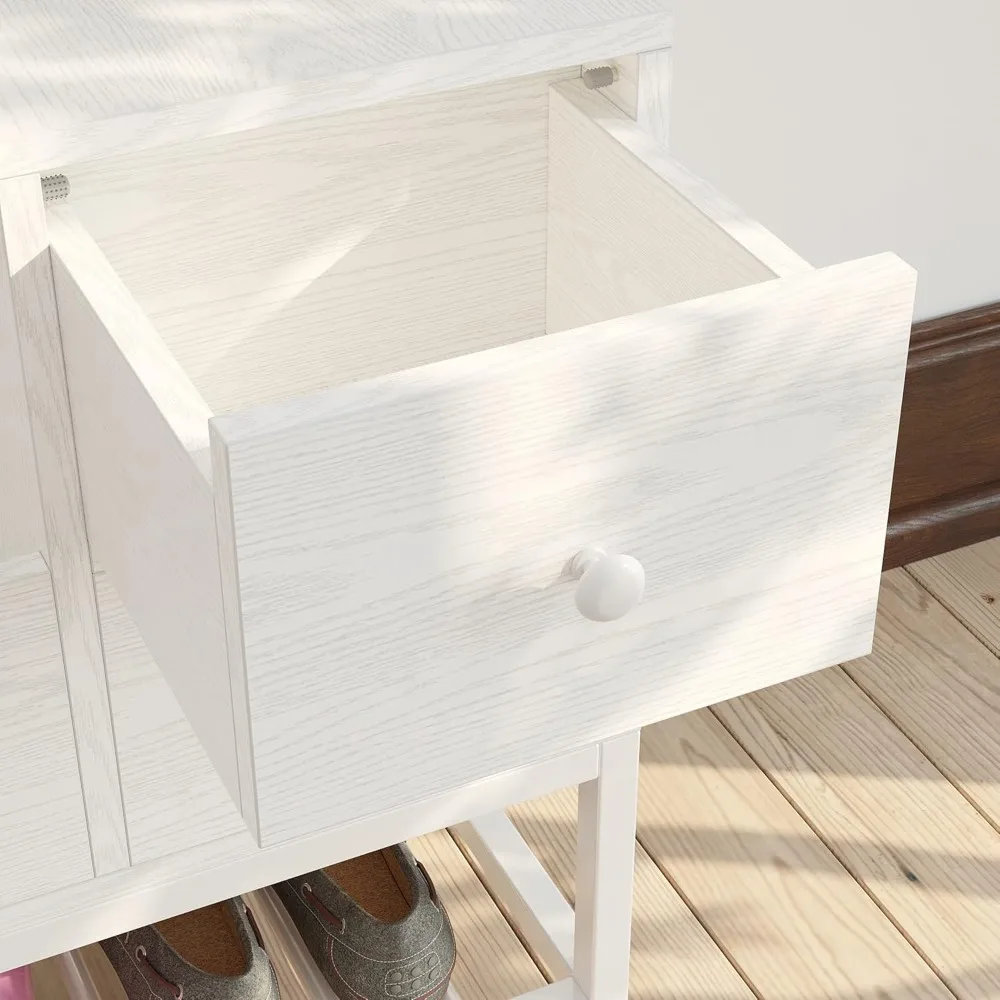
Design Details That Make a Statement
Beyond their practical functions, upholstered storage benches serve as distinctive design elements that can elevate your home’s aesthetic. Understanding the decorative features available helps you select a bench that makes the right visual statement while complementing your existing décor.
Decorative Elements
Tufting Patterns
Tufting creates dimensional interest and texture in upholstery:
– Diamond tufting: Creates the classic Chesterfield look with buttons at intersections of diagonal folds
– Button tufting: Individual buttons create a more casual, dotted appearance
– Channel tufting: Vertical or horizontal channels create a streamlined, contemporary look
– Biscuit tufting: Square or rectangular sections create a geometric, modern pattern
– Blind tufting: Creates indentations without visible buttons for subtle texture
Leg Styles
Legs significantly impact the bench’s overall style:
– Turned legs: Traditional styling with curves and details, often in wood
– Tapered legs: Angled, straight legs that narrow toward the floor for mid-century or transitional look
– Block legs: Square or rectangular legs for contemporary, sturdy appearance
– Hairpin legs: Metal legs with distinctive bend for industrial or mid-century modern style
– Hidden legs or plinth base: Creates floating appearance or solid foundation
Trim Details
These finishing touches can transform a basic bench:
– Nailhead trim: Metal studs creating borders or patterns, available in various finishes
– Welting/piping: Fabric-covered cord defining edges and seams
– Contrast stitching: Visible stitches in complementary or contrasting colors
– Decorative tape: Applied ribbon-like trim along seams or edges
– Fringe or tassels: More elaborate decorative elements for traditional or bohemian styles
Color Selection Strategies
The bench’s color establishes its role in your overall design scheme:
Neutral Territory
- Grays, beiges, taupes, and creams create versatile foundations
- Textural neutrals add interest without color commitment
- Easier to reposition throughout home as needs change
- Allows for accessorizing with seasonal colors through pillows or throws
Statement Colors
- Bold colors create focal points and energy
- Consider longevity—could you enjoy this color for years?
- Balance with neutrals elsewhere in the space
- Rich jewel tones like emerald, sapphire, or amethyst offer sophisticated drama
Color Psychology Considerations
- Blues and greens promote calm and relaxation
- Warm tones (reds, oranges, yellows) energize spaces
- Lighter colors make spaces feel larger
- Darker colors add weight and groundedness
Pattern Play
Patterns add personality and visual interest to upholstered pieces:
– Scale matters: Larger patterns make stronger statements while small patterns read as texture from a distance
– Geometric patterns create contemporary, structured feel
– Floral or organic patterns add traditional or bohemian character
– Stripes can elongate or widen the visual perception of the piece depending on direction
– Texture as pattern: Even solid fabrics can have significant textural interest through weave or pile
The complete guide to choosing compact bench options provides additional insights on selecting design elements that maximize both style and functionality in various spaces.
When selecting decorative elements, consider both your immediate aesthetic preferences and the long-term versatility of the piece. While trends come and go, quality construction and classic design elements create lasting appeal that can adapt to evolving décor preferences.
Styling Your Upholstered Storage Bench: Design Inspiration
Once you’ve selected the perfect upholstered storage bench, thoughtful styling enhances both its appearance and functionality. Different placements call for specific styling approaches to maximize the bench’s contribution to your space.
Entryway Styling
The entryway bench creates first impressions and sets the tone for your home:
- Create a welcoming vignette with a mirror or artwork above the bench
- Layer textural elements with a small area rug beneath the bench
- Add vertical balance with wall hooks or a coat rack alongside
- Place decorative baskets on or below the bench for additional visible storage
- Position a tray on one end of the bench for keys, mail, and small everyday items
- Incorporate seasonal elements that refresh the space throughout the year
For entryways where shoe storage is a priority, entryway furniture with shoe compartments can be styled to maintain organization while creating an inviting atmosphere.
Living Room Styling
In living areas, style your bench to integrate seamlessly with surrounding furniture:
- Position decorative trays to define areas for display items
- Layer decorative pillows in complementary colors and varying textures
- Place coffee table books with beautiful covers that invite browsing
- Include a throw blanket casually draped for warmth and texture
- Add a low-profile plant or decorative object for height variation
- Consider proportions relative to surrounding seating for visual balance
Bedroom Styling
At the foot of a bed, your bench styling should create harmony with bedding:
- Echo bedding colors in bench accessories for cohesion
- Position decorative pillows that complement but don’t exactly match bed pillows
- Place a folded throw in a contrasting texture to your bedding
- Consider a breakfast tray for functional decoration that suggests relaxation
- Keep styling minimal to maintain the calm atmosphere bedrooms require
- Ensure visual balance with bedroom furniture through color repetition
Creating Visual Balance
Regardless of location, these principles help create pleasing arrangements:
- Rule of thirds: Group accessories in odd numbers (typically 3 or 5)
- Height variation: Include items of different heights for visual interest
- Weight distribution: Balance heavier visual elements with lighter ones
- Negative space: Allow some empty space rather than crowding every surface
- Color repetition: Echo colors from elsewhere in the room for cohesion
- Contrast: Include elements that provide contrast in texture, shape, or color
Seasonal Styling Shifts
Keep your bench looking fresh with these seasonal updates:
Spring/Summer:
– Lighter textiles in breathable fabrics
– Botanical elements or floral patterns
– Brighter accent colors
– Natural elements like woven baskets
Fall/Winter:
– Heavier textures like wool, velvet, or faux fur
– Warmer color palettes
– Added layers with throws and pillows
– Metallic accents for subtle shimmer
Space-saving entry benches for small homes can be particularly transformed through thoughtful styling that maximizes their visual impact while maintaining their practical benefits.
The most successful bench styling balances decoration with function—ensuring the piece remains practical while contributing to your home’s overall aesthetic. Remember that less is often more, allowing the bench itself to shine while accessories complement rather than overwhelm.
Entryway Bench with Cushion, Mudroom Bench with Cushion, Shoe Bench for Entryway
$1,186.63 Select options This product has multiple variants. The options may be chosen on the product pageEntryway Bench with Back, Modern Entryway Bench, Shoe Bench for Entryway
Price range: $463.13 through $474.44 Select options This product has multiple variants. The options may be chosen on the product pageCorner Entryway Bench, Entryway Bench with Cushion, Modern Entryway Bench, Shoe Bench for Entryway
$476.34 Select options This product has multiple variants. The options may be chosen on the product pageBench with Hooks and Storage, Entryway Hall Tree, Mudroom Bench with Cubbies, Mudroom Bench with Shoe Storage
$818.38 Select options This product has multiple variants. The options may be chosen on the product pageModern Entryway Bench, Wood Entryway Bench, Wood Mudroom Bench
$497.69 Select options This product has multiple variants. The options may be chosen on the product pageEntryway Coat Rack Bench, Entryway Hall Tree, Farmhouse Mudroom Bench, Mudroom Bench with Shoe Storage
$805.09 Select options This product has multiple variants. The options may be chosen on the product page
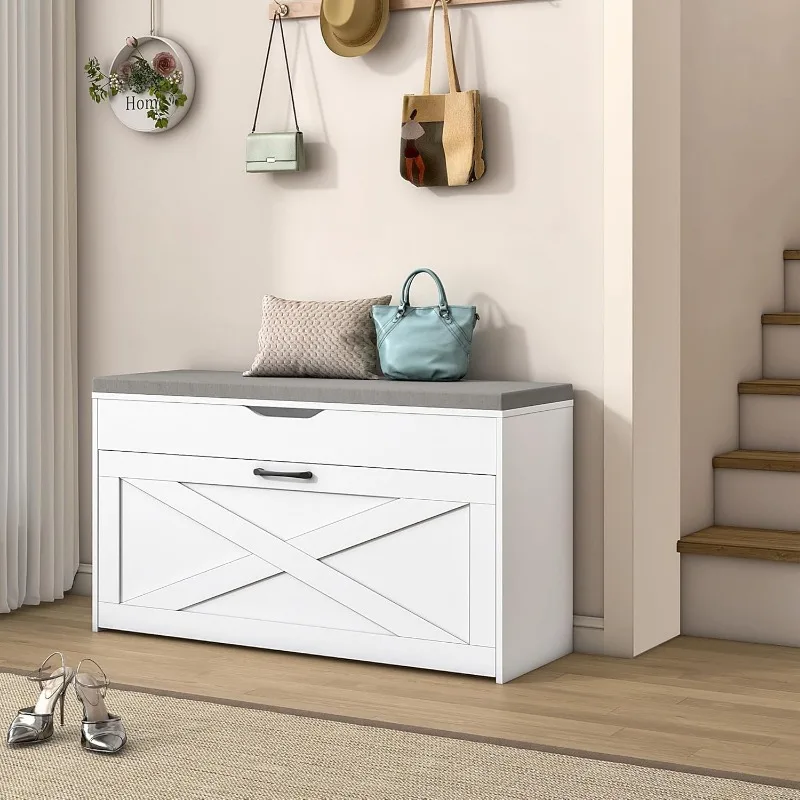
Smart Organization Strategies for Your Storage Bench
The hidden compartment in your upholstered storage bench offers valuable space—but without thoughtful organization, it can quickly become a chaotic catchall. Implementing smart storage strategies ensures you maximize this space while maintaining easy access to contents.
Purpose-Driven Organization
Begin by defining the bench’s specific storage purpose:
- Entryway bench: Seasonal accessories, shoe care, pet walking supplies
- Living room bench: Entertainment items, blankets, children’s toys
- Bedroom bench: Extra bedding, seasonal clothing, reading materials
- Dining area bench: Table linens, special occasion dishware, placemats
This clarity prevents the bench from becoming a miscellaneous dumping ground and ensures you store only appropriate items within it.
Compartmentalizing for Efficiency
Even within a single-compartment bench, creating divisions maximizes functionality:
- Adjustable dividers: Create custom-sized sections for different items
- Stackable bins: Utilize vertical space while keeping categories separate
- Canvas or fabric containers: Soft-sided organization that maximizes irregular spaces
- Drawer organizers: Repurpose these in bench compartments for smaller items
- File folders: Store important documents upright and accessible
For homes where space is particularly limited, space-saving entry benches for small homes benefit from especially thoughtful organization to maximize their capacity.
Rotation Strategies for Seasonal Items
Many storage benches house seasonal items that change throughout the year:
- Implement quarterly rotation of seasonal accessories and clothing
- Use vacuum storage bags for off-season textiles to minimize space requirements
- Label containers clearly so seasonal switchovers become simple
- Keep current season items most accessible at the front or top
- Photograph contents of less-frequently accessed storage for easy reference
Quick-Access vs. Deep Storage Approaches
Not all stored items need the same accessibility:
- Frequently used items: Position these at the front or in dedicated sections
- Emergency items: Store these in brightly colored containers for quick identification
- Rarely used items: Place these at the back or bottom but still with clear labeling
- Create a map of container contents taped inside the lid for quick reference
- Consider transparent containers for immediate visual identification
Maintenance for Long-Term Organization
Even the best organization systems require maintenance:
- Schedule quarterly “bench audits” to remove unnecessary items
- Implement a one-in-one-out policy for appropriate categories
- Keep a small container for items that belong elsewhere
- Vacuum or wipe out the interior during seasonal rotations
- Reassess organization systems if they’re not functioning optimally
The goal of any storage bench organization system should be finding items quickly without disrupting the bench’s appearance when closed. With thoughtful planning and occasional maintenance, your upholstered storage bench can remain a highly functional organizational asset rather than becoming another cluttered space.
Care and Maintenance for Lasting Beauty
Proper maintenance ensures your upholstered storage bench remains beautiful and functional for years to come. Different materials and construction types require specific care approaches to preserve their appearance and structural integrity.
Fabric Upholstery Care
Regular maintenance prevents dirt buildup and extends fabric life:
- Vacuum weekly using upholstery attachment with low suction
- Rotate cushions (if removable) to ensure even wear
- Address spills immediately by blotting (not rubbing) with clean, white cloths
- Follow manufacturer’s cleaning codes (W for water-based cleaners, S for solvent cleaners, X for professional cleaning only)
- Test cleaning products on hidden areas before applying broadly
- Schedule professional cleaning annually for heavily used benches
Leather and Vinyl Care
These materials require different approaches than fabric:
- Dust regularly with a clean, dry cloth
- Wipe leather with leather cleaner or mild soap solution quarterly
- Apply leather conditioner to genuine leather 2-4 times per year
- Clean vinyl with vinyl-specific products that won’t cause cracking
- Keep away from direct sunlight to prevent fading and drying
- Address scratches in leather with appropriate leather repair products
For benches with cushioned seating, shoe bench cushion maintenance is particularly important as these areas often see more concentrated wear from daily use.
Treating Common Stains
Quick action with the right approach prevents permanent damage:
| Stain Type | Fabric Treatment | Leather/Vinyl Treatment |
|---|---|---|
| Water-based (coffee, juice) | Blot with clean cloth, mild soap solution, rinse with water | Wipe immediately with damp cloth |
| Oil-based (grease, makeup) | Blot excess, apply cornstarch, vacuum after drying, use solvent cleaner if needed | Blot gently, clean with leather/vinyl cleaner |
| Ink | Blot (don’t rub), alcohol on cotton ball for synthetic fabrics, professional cleaning for natural fibers | Specialized leather/vinyl ink remover only |
| Pet accidents | Enzymatic cleaner specifically for pet stains | Wipe immediately, clean with appropriate cleaner |
Mechanical Maintenance
Don’t forget the working parts of your storage bench:
- Lubricate hinges annually with appropriate lubricant
- Tighten loose screws in hinges, legs, and support structures
- Check safety mechanisms on lift-tops to ensure proper function
- Adjust drawer slides if they begin to stick or bind
- Inspect support structures annually for any signs of weakening
Preventative Care
Taking these steps helps avoid damage before it occurs:
- Use arm covers or throws in high-wear areas
- Consider fabric protection treatments for new benches
- Place felt pads under legs to protect flooring and prevent movement
- Avoid placing benches in direct sunlight to prevent fading
- Consider humidity levels in the room (extreme dryness or humidity can affect wood frames)
Regular maintenance not only preserves appearance but also protects your investment. A well-maintained upholstered storage bench can remain beautiful and functional for many years, making the initial quality investment even more valuable over time.
Investment Considerations: Budgeting for Quality
When shopping for upholstered storage benches, understanding the relationship between price and quality helps ensure you make a wise investment. While budget naturally influences decisions, considering long-term value often leads to more satisfying purchases.
Price Range Expectations
Upholstered storage benches vary widely in price based on size, materials, and construction quality:
| Quality Level | Price Range | What to Expect |
|---|---|---|
| Budget | $100-$250 | Engineered wood construction, synthetic upholstery, basic mechanisms |
| Mid-Range | $250-$500 | Better frame construction, higher-quality fabrics, improved mechanisms |
| Premium | $500-$1,000 | Solid hardwood frames, high-performance fabrics or leather, premium features |
| Luxury | $1,000+ | Designer brands, finest materials, custom options, exceptional craftsmanship |
Where to Invest vs. Where to Save
Strategic decisions can maximize value without unnecessary spending:
Worth the Splurge:
– Frame construction quality (directly impacts longevity)
– Upholstery fabric durability (affects appearance over time)
– Hinge and hardware quality (prevents mechanical failures)
– Comfort features for frequently used seating
Areas to Save:
– Highly trendy designs that might look dated quickly
– Decorative elements that can be added separately
– Designer name recognition when comparable quality exists
– Maximum storage capacity if you need only moderate storage
For budget-conscious shoppers, affordable entryway bench solutions provide options that balance cost with quality and functionality.
Value Metrics Beyond Price
The true value of an upholstered storage bench includes factors beyond the initial cost:
- Cost per use: Frequently used pieces justify higher investment
- Versatility: Benches that can serve multiple functions or locations offer greater value
- Longevity: Quality construction that lasts years longer amortizes cost over time
- Warranty coverage: Comprehensive warranties can justify higher upfront costs
- Resale value: Better-constructed pieces with timeless design retain value
Questions to Ensure Value at Any Price Point
Before purchasing, ask these questions to ensure you’re getting the best value:
- How is the frame constructed, and what materials are used?
- What is the weight capacity for both seating and storage?
- Are the upholstery materials appropriate for your intended use?
- How are the cushions constructed and can they be replaced if needed?
- What warranty is provided and what specifically does it cover?
- Does the design have longevity or is it likely to look dated quickly?
Cost-Saving Strategies Without Compromising Quality
Consider these approaches to maximize value:
– Shop floor models or open-box items from reputable retailers
– Look for seasonal sales on furniture (typically January, July, and holiday weekends)
– Consider customizable options where you can prioritize structural quality over expensive upholstery
– Research brands known for balancing quality with reasonable pricing
– Look for multi-function designs that replace multiple furniture pieces
At Nested Goods, we believe in providing premium storage solutions that represent genuine value through quality construction, thoughtful design, and lasting functionality—ensuring your investment continues to enhance your home for years to come.
Beyond Basic Storage: Specialized Features Worth Considering
As upholstered storage benches have evolved, manufacturers have introduced innovative features that enhance functionality beyond basic seating and storage. These specialized options can significantly increase a bench’s utility and convenience for specific needs and situations.
Enhanced Storage Features
Modern storage benches often include thoughtful organizational elements:
- Adjustable or removable dividers that customize the interior storage space
- Built-in trays that create shallow compartments for smaller items
- Charging stations with integrated USB ports or power outlets
- Hidden compartments for valuable or private items
- Lined interiors that protect delicate contents and reduce noise
Multi-Functional Elements
Some benches transcend simple storage to offer remarkable versatility:
- Convertible designs that transform from benches to tables or other furniture pieces
- Nesting components that can be separated for flexible use
- Flip-top surfaces that create workspace or dining surfaces when needed
- Built-in lighting activated when the storage compartment opens
- Climate-controlled compartments for specialized storage needs
For apartment dwellers especially, compact storage benches for small apartment living offer innovative space-maximizing features that address the unique challenges of limited square footage.
Accessibility Considerations
Thoughtful design features can make benches more user-friendly:
- Slow-close mechanisms that prevent pinched fingers
- Push-to-open systems that eliminate the need for handles
- Lightweight lid materials that reduce opening effort
- Front-opening access for those who have difficulty with top-opening designs
- Hydraulic lift assists that make heavy lids manageable
Custom Options for Specific Needs
Beyond standard offerings, consider these customization possibilities:
- Made-to-measure dimensions for unusual spaces or specific storage needs
- Performance fabric upgrades for high-traffic or specialized environments
- Split-lid designs that allow access to specific sections without opening the entire top
- Integrated power features for technology-friendly spaces
- Modular components that work together as needs change
Future Trends in Storage Bench Design
Looking ahead, watch for these emerging innovations:
- Smart storage solutions with inventory tracking or automated organization
- Sustainable materials with reduced environmental impact
- Modular systems that adapt to changing household needs
- Multisensory designs incorporating sound absorption or aromatherapy elements
- Biophilic features that integrate natural elements for wellbeing
As storage benches continue to evolve, these specialized features transform basic furniture into sophisticated solutions for modern living. When selecting your upholstered storage bench, consider which enhanced features might provide particular value for your lifestyle and specific needs.
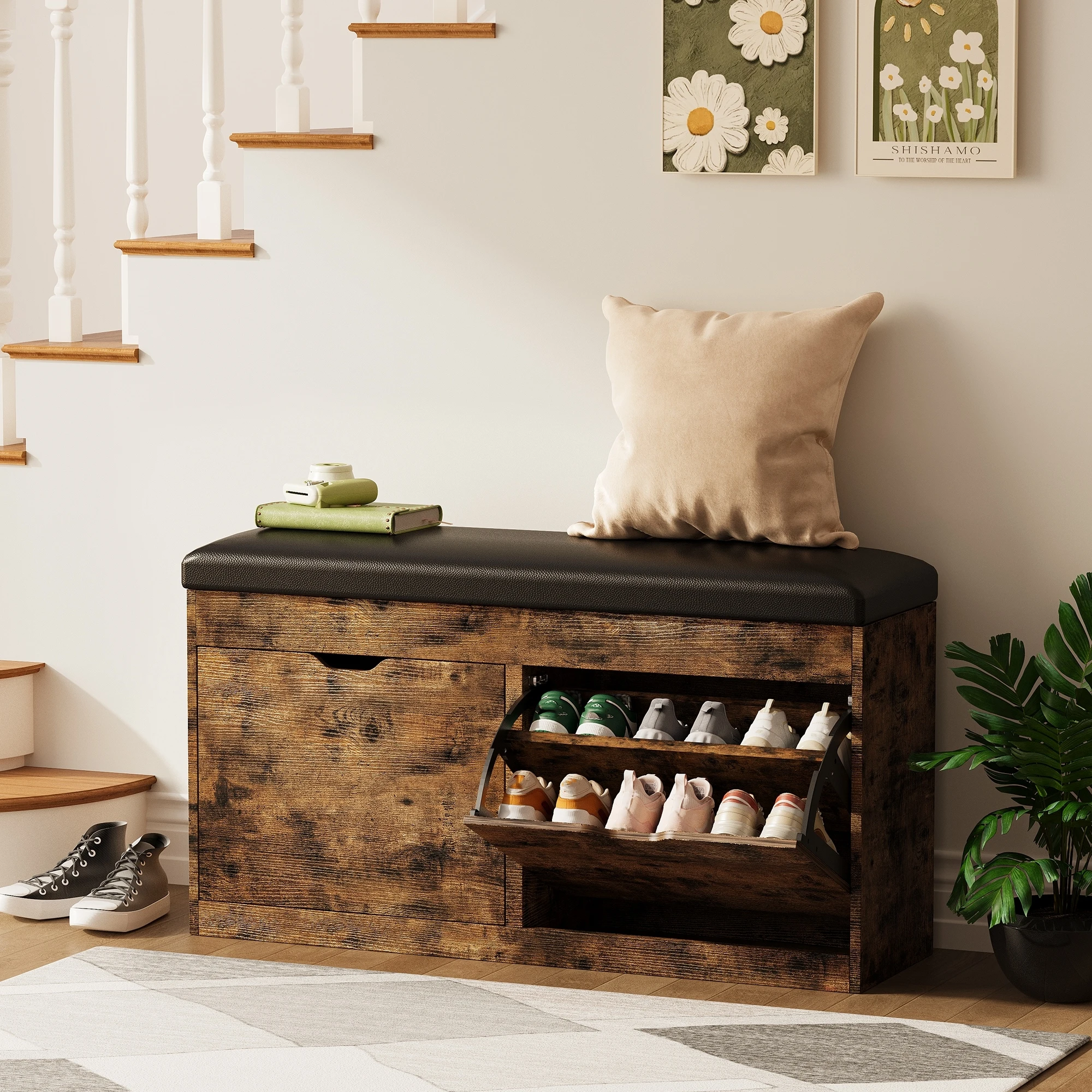
Are Upholstered Storage Benches Child and Pet Friendly?
Families with children and pets have special considerations when selecting furniture. Upholstered storage benches can be excellent family-friendly options when chosen with specific features and materials in mind.
Safety Considerations for Children
When children are present, prioritize these safety features:
- Soft-close hinges that prevent lid slamming and potential finger injuries
- Rounded corners rather than sharp edges that could cause injury
- Sturdy construction with adequate weight capacity for climbing children
- Non-toxic materials and finishes free from harmful chemicals
- Secure lid closure that prevents accidental trapping if a child climbs inside
- Stability testing to prevent tipping when leaned or climbed upon
Importantly, any storage bench accessible to young children should have safety hinges or alternative opening mechanisms that prevent accidental closure while little hands or heads are near the opening.
Pet-Friendly Material Choices
For households with four-legged family members, certain materials offer superior performance:
- Tightly woven synthetic fabrics that resist claw snags
- Performance fabrics designed specifically to repel pet hair and resist stains
- Leather or vinyl options that can be wiped clean of pet hair and accidents
- Darker colors or patterns that conceal hair between cleanings
- Removable/washable covers for easy maintenance
Avoid delicate fabrics like silk or loose weaves that easily catch claws, as well as light colors that show pet hair prominently.
Design Elements for Family Living
These design features enhance family functionality:
- Compartmentalized storage perfect for organizing toys or pet supplies
- Wipeable/cleanable surfaces that stand up to sticky fingers
- Stain-resistant treatments that protect against spills and accidents
- Durable construction that withstands the rigors of family use
- Versatile placement options that adapt to changing family needs
Space-saving entryway seating solutions can be particularly valuable for families, creating organized drop zones that help contain the natural chaos of family comings and goings.
Common Family-Use Issues and Solutions
| Issue | Solution |
|---|---|
| Spills and stains | Choose stain-resistant fabrics with moisture barriers |
| Rough use | Select benches with reinforced seams and corners |
| Pet hair accumulation | Opt for smooth fabrics that release hair easily when vacuumed |
| Changing needs | Look for versatile designs that adapt to growing children |
| Limited space | Choose multi-functional pieces that replace multiple furniture items |
Making the Final Decision
For family households, consider these questions before purchasing:
- Does the bench have any pinch points or sharp edges that could harm children?
- Are the materials durable enough for your specific pets’ behaviors?
- Can the upholstery be cleaned easily when inevitable accidents occur?
- Is the storage accessible enough for children to help with cleanup?
- Does the bench’s function support your family’s daily routines and activities?
With thoughtful selection, an upholstered storage bench can become one of the most practical and beloved pieces in a family home—providing organization, seating, and style that accommodates everyone from the youngest family members to furry friends.
How Do You Reupholster a Storage Bench?
Breathing new life into an existing storage bench through reupholstering can be both economical and satisfying. While professional upholstery offers premium results, many storage benches—particularly those with simple, flat cushioned tops—make excellent DIY projects for those with basic skills.
Assessing Your Project
Before beginning, evaluate:
- Complexity level: Simple flat-top benches are easiest; tufted or complex shapes require more skill
- Frame condition: Ensure the underlying structure remains solid and stable
- Original construction: How the piece was initially assembled affects your approach
- Required tools: Basic projects need staple gun, fabric scissors, and basic hand tools
- Time commitment: Simple benches might take 2-4 hours; complex designs much longer
Materials Needed
Gather these supplies before beginning:
- New upholstery fabric (typically 2-3 yards depending on bench size)
- Appropriate thread matching your fabric
- Staple gun and staples (electric stapler recommended for ease)
- Sharp fabric scissors
- Screwdriver to remove hardware
- New padding if original is compressed or damaged
- Upholstery tacks or gimp trim to hide staples if needed
Simplified Process Overview
- Document the original: Take photos of the bench from all angles before disassembly
- Remove old fabric: Carefully remove staples and note the order of fabric layers
- Evaluate padding: Replace or supplement foam if compressed or damaged
- Create templates: Use old fabric as pattern for cutting new pieces
- Cut new fabric: Allow extra margin around edges for attachment
- Attach new fabric: Working from center outward to avoid wrinkles
- Finish corners: Create neat folds at corners for professional appearance
- Reattach hardware: Replace hinges and any other removed components
Professional vs. DIY Considerations
Professional reupholstering might be preferable when:
– The bench has complex tufting or curved surfaces
– The project requires matching patterns precisely
– The bench has significant structural issues needing repair
– The fabric is particularly expensive or difficult to work with
– Time constraints make DIY impractical
DIY reupholstering works well when:
– The bench has simple, flat surfaces
– You’re comfortable with basic tools and have workspace
– The existing construction is straightforward
– You’re working with forgiving fabrics
– You enjoy hands-on projects
For many homeowners, reupholstering represents a middle ground between purchasing new furniture and continuing to use pieces that no longer match current décor preferences. With basic skills and the right materials, many storage benches can be transformed for a fraction of replacement cost.
Which Rooms Should Avoid Upholstered Storage Benches?
While upholstered storage benches offer remarkable versatility, certain environments present challenges that can compromise both their appearance and functionality. Understanding these limitations helps ensure appropriate placement and longevity.
Moisture-Prone Spaces
Upholstered benches typically don’t fare well in high-humidity or wet areas:
- Bathrooms: Constant humidity can promote mold growth within padding and wooden frames
- Outdoor or semi-outdoor spaces: Without specialized weather-resistant materials, exposure to elements causes rapid deterioration
- Pool areas: Chlorine and water exposure damages standard upholstery fabrics and padding
- Basement areas prone to dampness: Moisture absorption can lead to mildew and musty odors
Alternative solution: For these spaces, consider fully waterproof benches made of plastic, resin, or specially treated woods with removable water-resistant cushions that can be stored during high-moisture periods.
High-Heat Areas
Heat sources can damage upholstery materials and potentially create safety hazards:
- Directly adjacent to fireplaces: Heat exposure can dry out leathers, damage adhesives, and create fire risk
- Near heating vents or radiators: Direct heat flow causes uneven wear and potential fabric deterioration
- Sunrooms with extreme temperature fluctuations: Can stress materials and accelerate fading
- Outdoor areas with direct sun exposure: UV damage rapidly degrades most standard upholstery
Alternative solution: Choose metal or solid wood benches with heat-resistant finishes for these locations, or ensure significant clearance between heat sources and upholstered furniture.
Spaces with Specialized Functional Requirements
Some areas have specific needs that standard upholstered benches don’t adequately address:
- Commercial entryways: May require fire-rated materials not found in residential pieces
- Industrial settings: Need more robust construction than typical residential benches provide
- Healthcare environments: Require antimicrobial surfaces that can withstand medical-grade cleaning
- Food preparation areas: Need easily sanitized surfaces rather than fabric that can harbor bacteria
For homes where space optimization is critical, maximizing small spaces with smart entryway bench strategies can help identify appropriate placements that avoid problematic conditions while maximizing functionality.
Risk Assessment for Borderline Placements
When considering placement in potentially challenging locations, evaluate:
- Exposure duration: Occasional versus constant exposure to adverse conditions
- Material specifications: Some specialized fabrics offer enhanced resistance to typical problems
- Protective options: Whether covers or treatments might mitigate risks
- Usage patterns: How the bench will be used in the specific environment
- Maintenance commitment: Your willingness to perform additional care in challenging locations
While certain spaces should generally avoid upholstered storage benches, advancing materials technology continues to expand placement possibilities. Performance fabrics, specialized treatments, and innovative construction methods increasingly allow these versatile pieces to function in previously unsuitable environments.
FAQ: What’s the Difference Between Storage Benches and Storage Ottomans?
Shoppers often encounter both storage benches and storage ottomans when searching for multifunctional furniture. While these pieces share similarities, understanding their differences helps determine which best suits your specific needs.
Design and Structure Differences
Storage Benches:
– Typically rectangular with defined sides and back in many cases
– Often feature legs that elevate them several inches off the floor
– Generally designed for seating as primary function
– Usually have a more structured, furniture-like appearance
– Frequently include backs and sometimes arms for comfortable seating
Storage Ottomans:
– Often square, round, or occasionally rectangular
– Typically rest directly on the floor or have very short legs
– Primarily designed as footrests that offer secondary seating
– Feature a more casual, versatile appearance
– Rarely include backs or arms, offering 360-degree access
Functional Differences and Best Uses
Storage Benches Excel At:
– Providing primary, comfortable seating for longer periods
– Creating defined boundaries between spaces in open floor plans
– Offering larger storage capacity for bulkier items
– Serving as standalone furniture pieces that anchor a space
– Creating a more formal, intentional presence in a room
Storage Ottomans Excel At:
– Functioning as flexible footrests that convert to occasional seating
– Moving easily around a room to serve different purposes
– Providing convenient tabletop surface when topped with trays
– Fitting into smaller spaces or underneath console tables
– Creating a more casual, adaptable presence
Aesthetic Differences
Storage Benches:
– Make stronger style statements as standalone furniture
– Often feature more elaborate upholstery details like tufting or nailhead trim
– Frequently incorporate mixed materials (wood frames with upholstered tops)
– Generally align with traditional furniture categories (dining bench, entryway bench)
– Create more visual weight and presence in a room
Storage Ottomans:
– Blend more seamlessly with existing furniture groupings
– Often feature simpler upholstery with fewer decorative elements
– Typically uniform in material throughout the piece
– More frequently follow current trends in shape and style
– Create lighter visual presence that complements rather than anchors
Decision Framework
Consider these questions when choosing between the options:
- Primary use? Seating-first needs favor benches; footrest-first needs favor ottomans
- Space constraints? Tight spaces may better accommodate more compact ottomans
- Storage volume needed? Larger items require the typically deeper bench storage
- Formality level? More formal spaces generally benefit from the structure of benches
- Flexibility requirements? Need for frequent movement favors lighter ottomans
Both furniture types offer valuable combinations of seating and storage, but their distinct characteristics make each better suited to specific environments and needs. Many homeowners find that both pieces have places in their homes—benches in entryways or dining areas, and ottomans in living spaces—each contributing their unique blend of function and style.

